Design and Development of Complex Phase Steels with Improved Combination of Strength and Stretch-Flangeability
Abstract
1. Introduction
2. Preliminary Investigations
2.1. Selection of Reheating Temperature
2.2. Austenite Recrystallization Kinetics and Strain-Induced Precipitation
2.3. Continuous Cooling Phase Transformation
3. Pilot Plant Hot Rolling Trials
3.1. Definition of Hot-Rolling Strategies
- Reheating at 1250 , ensuring a full dissolution of pre-existing (Ti,Nb)C precipitates (see Section 2.1).
- Rough rolling or roughing.
- Finish rolling or finishing.
- Accelerated cooling at 20– 40 s−1 starting from the finishing rolling temperature (FRT) down to the simulated coiling temperature.
- Slow cooling down to room temperature once the coiling temperature is reached.
- First, a recrystallization-controlled rolling strategy was tested (Figure 6a), with a finishing rolling temperature of 1050 . For this deformation scheme, all deformation passes were performed well above the temperature of no-recrystallization. In these conditions, austenite recrystallizes between each deformation pass, leading to grain refinement before accelerated cooling.
- Second, a more classical thermo-mechanical control process strategy was tested (Figure 6b). For this strategy, the two roughing passes are performed above 1050 leading to austenite grain refinement by recrystallization. After a waiting period of 30 s, the finishing stage was performed starting from 1050 , with a finishing rolling temperature of 880 . Therefore, most of the finishing passes were performed below , resulting in pancaked austenite.
3.2. Microstructures and Mechanical Properties
3.2.1. Methods
3.2.2. Microstructures
3.2.3. Mechanical Properties
4. Industrial Production Trial
5. Discussion
6. Conclusions
Author Contributions
Funding
Acknowledgments
Conflicts of Interest
References
- ISO 16630:2017:Metallic Materials-Sheet and Strip-Hole Expanding Test; ISO: Geneva, Switzerland, 2017.
- Fonstein, N. Complex Phase Steels. In Advanced High Strength Sheet Steels; Springer: Berlin, Germany, 2015; pp. 241–258. [Google Scholar]
- Funakawa, Y.; Shiozaki, T.; Tomita, K.; Yamamoto, T.; Maeda, E. Development of high strength hot-rolled sheet steel consisting of ferrite and nanometer-sized carbides. ISIJ Int. 2004, 44, 1945–1951. [Google Scholar] [CrossRef]
- Kamibayashi, K.; Tanabe, Y.; Takemoto, Y.; Shimizu, I.; Senuma, T. Influence of Ti and Nb on the strength–ductility–hole expansion ratio balance of hot-rolled low-carbon high-strength steel sheets. ISIJ Int. 2012, 52, 151–157. [Google Scholar] [CrossRef]
- Fang, X.; Fan, Z.; Ralph, B.; Evans, P.; Underhill, R. Effects of tempering temperature on tensile and hole expansion properties of a C-Mn steel. J. Mater. Process. Technol. 2003, 132, 215–218. [Google Scholar] [CrossRef]
- Azuma, M.; Goutianos, S.; Hansen, N.; Winther, G.; Huang, X. Effect of hardness of martensite and ferrite on void formation in dual phase steel. Mater. Sci. Technol. 2012, 28, 1092–1100. [Google Scholar] [CrossRef]
- Tsipouridis, P.; Werner, E.; Krempaszky, C.; Tragl, E. Formability of High Strength Dual-phase Steels. Steel Res. Int. 2006, 77, 654–667. [Google Scholar] [CrossRef]
- Tsai, S.P.; Su, T.C.; Yang, J.R.; Chen, C.Y.; Wang, Y.T.; Huang, C.Y. Effect of Cr and Al additions on the development of interphase-precipitated carbides strengthened dual-phase Ti-bearing steels. Mater. Des. 2017, 119, 319–325. [Google Scholar] [CrossRef]
- Sudo, M.; Hashimoto, S.I.; Kambe, S. Niobium bearing ferrite-bainite high strength hot-rolled sheet steel with improved formability. Trans. Iron Steel Inst. Jpn. 1983, 23, 303–311. [Google Scholar] [CrossRef]
- Bhadeshia, H.K.D.H. Bainite in Steels: Theory and Practice, 3rd ed.; Maney Publishing: Leeds, UK, 2015. [Google Scholar]
- Cizek, P.; Wynne, B.; Davies, C.; Muddle, B.C.; Hodgson, P.D. Effect of composition and austenite deformation on the transformation characteristics of low-carbon and ultralow-carbon microalloyed steels. Metall. Mater. Trans. A 2002, 33, 1331–1349. [Google Scholar] [CrossRef]
- Zhao, M.C.; Yang, K.; Xiao, F.R.; Shan, Y.Y. Continuous cooling transformation of undeformed and deformed low carbon pipeline steels. Mater. Sci. Eng. A 2003, 355, 126–136. [Google Scholar] [CrossRef]
- Kong, J.; Xie, C. Effect of molybdenum on continuous cooling bainite transformation of low-carbon microalloyed steel. Mater. Des. 2006, 27, 1169–1173. [Google Scholar] [CrossRef]
- Hu, H.; Xu, G.; Wang, L.; Xue, Z.; Zhang, Y.; Liu, G. The effects of Nb and Mo addition on transformation and properties in low carbon bainitic steels. Mater. Des. 2015, 84, 95–99. [Google Scholar] [CrossRef]
- Hu, J.; Du, L.X.; Wang, J.J. Effect of cooling procedure on microstructures and mechanical properties of hot-rolled Nb-Ti bainitic high strength steel. Mater. Sci. Eng. A 2012, 554, 79–85. [Google Scholar] [CrossRef]
- Gladman, T. The Physical Metallurgy of Microalloyed Steels; Number 792 in Book / The Institute of Materials; Maney: London, UK, 2002. [Google Scholar]
- Graux, A.; Cazottes, S.; De Castro, D.; San Martín, D.; Capdevila, C.; Cabrera, J.M.; Molas, S.; Schreiber, S.; Mirković, D.; Danoix, F.; et al. Precipitation and grain growth modelling in Ti-Nb microalloyed steels. Materialia 2019, 5, 100233. [Google Scholar] [CrossRef]
- Garcıa de Andres, C.; Caballero, F.; Capdevila, C.; San Martin, D. Revealing austenite grain boundaries by thermal etching: advantages and disadvantages. Mater. Charact. 2002, 49, 121–127. [Google Scholar] [CrossRef]
- Karjalainen, L.P. Stress relaxation method for investigation of softening kinetics in hot deformed steels. Mater. Sci. Technol. 1995, 11, 557–565. [Google Scholar] [CrossRef]
- Liu, W.; Jonas, J. A stress relaxation method for following carbonitride precipitation in austenite at hot working temperatures. Metall. Trans. A 1988, 19, 1403–1413. [Google Scholar] [CrossRef]
- Humphreys, F.J.; Rohrer, G.S.; Rollett, A.D. Recrystallization and Related Annealing Phenomena, 3rd ed.; Elsevier: Amsterdam, The Netherlands; Oxford, UK; Cambridge, MA, USA, 2017. [Google Scholar]
- Peet, M.; Bhadeshia, H. Program MAP_STEEL_MUCG83. Materials Algorithms Project. 2006. Available online: http://www.msm.cam.ac.uk/map/steel/programs/mucg83.html (accessed on 6 June 2020).
- Jha, G.; Haldar, A.; Bhaskar, M.; Venugopalan, T. Development of high strength hot-rolled steel sheet for wheel disc application. Mater. Sci. Technol. 2011, 27, 1131–1137. [Google Scholar] [CrossRef]
- Jha, G.; Das, S.; Lodh, A.; Haldar, A. Development of hot-rolled steel sheet with 600 MPa UTS for automotive wheel application. Mater. Sci. Eng. A 2012, 552, 457–463. [Google Scholar] [CrossRef]
- Wang, X.P.; Zhao, A.M.; Zhao, Z.Z.; Huang, Y.; Li, L.; He, Q. Mechanical properties and characteristics of nanometer-sized precipitates in hot-rolled low-carbon ferritic steel. Int. J. Miner. Metall. Mater. 2014, 21, 266–272. [Google Scholar] [CrossRef]
- Nikravesh, M.; Naderi, M.; Akbari, G.H. Influence of hot plastic deformation and cooling rate on martensite and bainite start temperatures in 22MnB5 steel. Mater. Sci. Eng. A 2012, 540, 24–29. [Google Scholar] [CrossRef]
- Hase, K.; Garcia-Mateo, C.; Bhadeshia, H. Bainite formation influenced by large stress. Mater. Sci. Technol. 2004, 20, 1499–1505. [Google Scholar] [CrossRef]
- Jun, H.; Kang, J.; Seo, D.; Kang, K.; Park, C. Effects of deformation and boron on microstructure and continuous cooling transformation in low carbon HSLA steels. Mater. Sci. Eng. A 2006, 422, 157–162. [Google Scholar] [CrossRef]
- Yamamoto, S.; Yokoyama, H.; Yamada, K.; Niikura, M. Effects of the austenite grain size and deformation in the unrecrystallized austenite region on bainite transformation behavior and microstructure. ISIJ Int. 1995, 35, 1020–1026. [Google Scholar] [CrossRef]
- Fujiwara, K.; Okaguchi, S.; Ohtani, H. Effect of hot deformation on bainite structure in low carbon steels. ISIJ Int. 1995, 35, 1006–1012. [Google Scholar] [CrossRef]
- Zajac, S.; Schwinn, V.; Tacke, K. Characterisation and Quantification of Complex Bainitic Microstructures in High and Ultra-High Strength Linepipe Steels. Mater. Sci. Forum 2005, 500–501, 387–394. [Google Scholar] [CrossRef]
- Andersson, J.O.; Helander, T.; Höglund, L.; Shi, P.; Sundman, B. Thermo-Calc & DICTRA, computational tools for materials science. Calphad 2002, 26, 273–312. [Google Scholar] [CrossRef]
- Weißensteiner, I.; Suppan, C.; Hebesberger, T.; Winkelhofer, F.; Clemens, H.; Maier-Kiener, V. Effect of Morphological Differences on the Cold Formability of an Isothermally Heat-Treated Advanced High-Strength Steel. JOM 2018, 70, 1567–1575. [Google Scholar] [CrossRef]
- Pathak, N.; Butcher, C.; Worswick, M.; Bellhouse, E.; Gao, J. Damage evolution in complex-phase and dual-phase steels during edge stretching. Materials 2017, 10, 346. [Google Scholar] [CrossRef]
- Karjalainen, A.; Kesti, V.; Vierelä, R.; Ylitolva, M.; Porter, D.; Kömi, J. The Effect of Microstructure on the Sheared Edge Quality and Hole Expansion Ratio of Hot-Rolled 700 MPa Steel; IOP Publishing: Bristol, UK, 2017; Volume 896, p. 012103. [Google Scholar]
- Yan, W.; Shan, Y.; Yang, K. Effect of TiN inclusions on the impact toughness of low-carbon microalloyed steels. Metall. Mater. Trans. A 2006, 37, 2147–2158. [Google Scholar] [CrossRef]
- Medina, S.F.; Chapa, M.; Valle, P.; Quispe, A.; Vega, M.I. Influence of Ti and N contents on austenite grain control and precipitate size in structural steels. ISIJ Int. 1999, 39, 930–936. [Google Scholar]
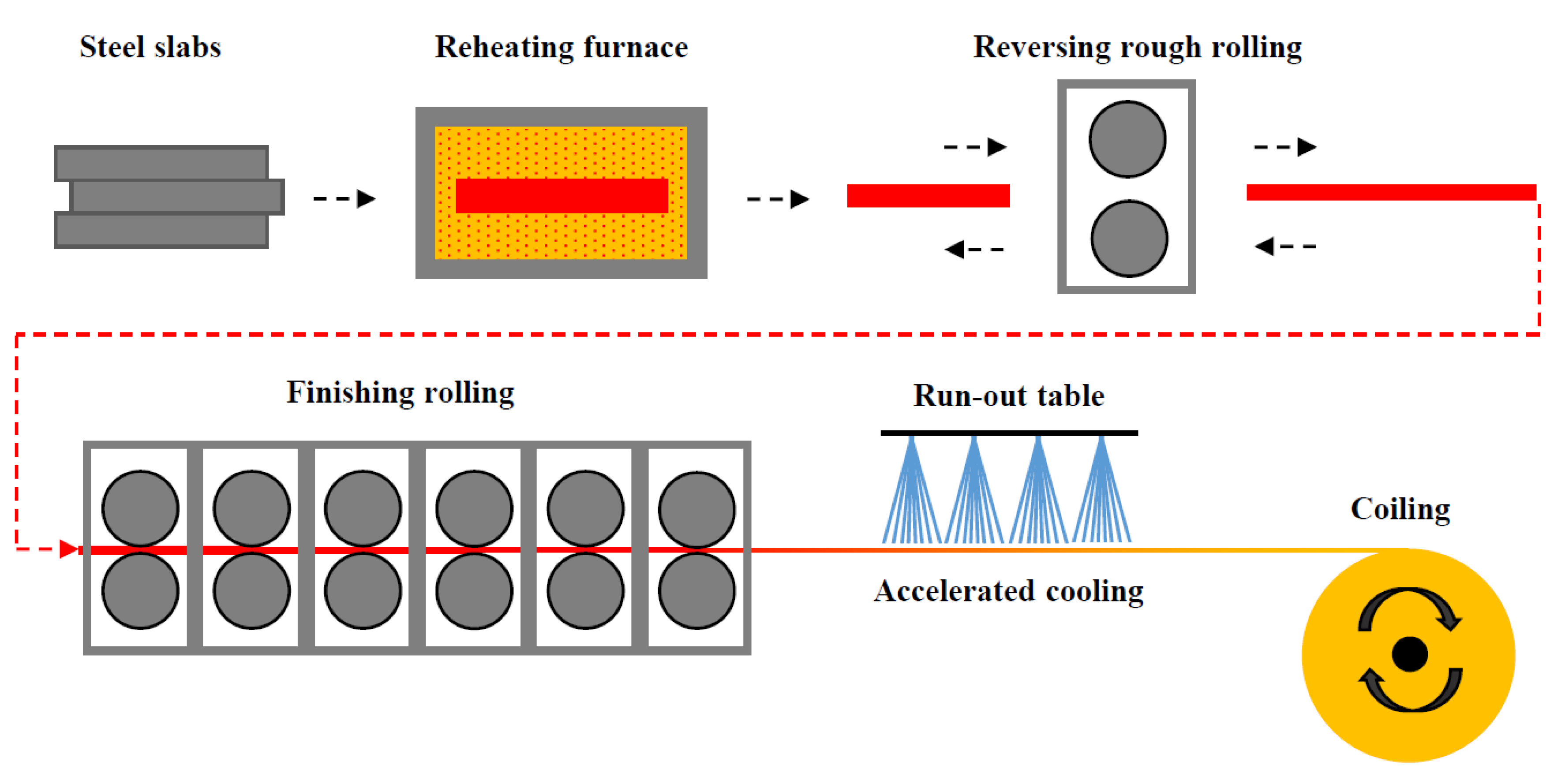
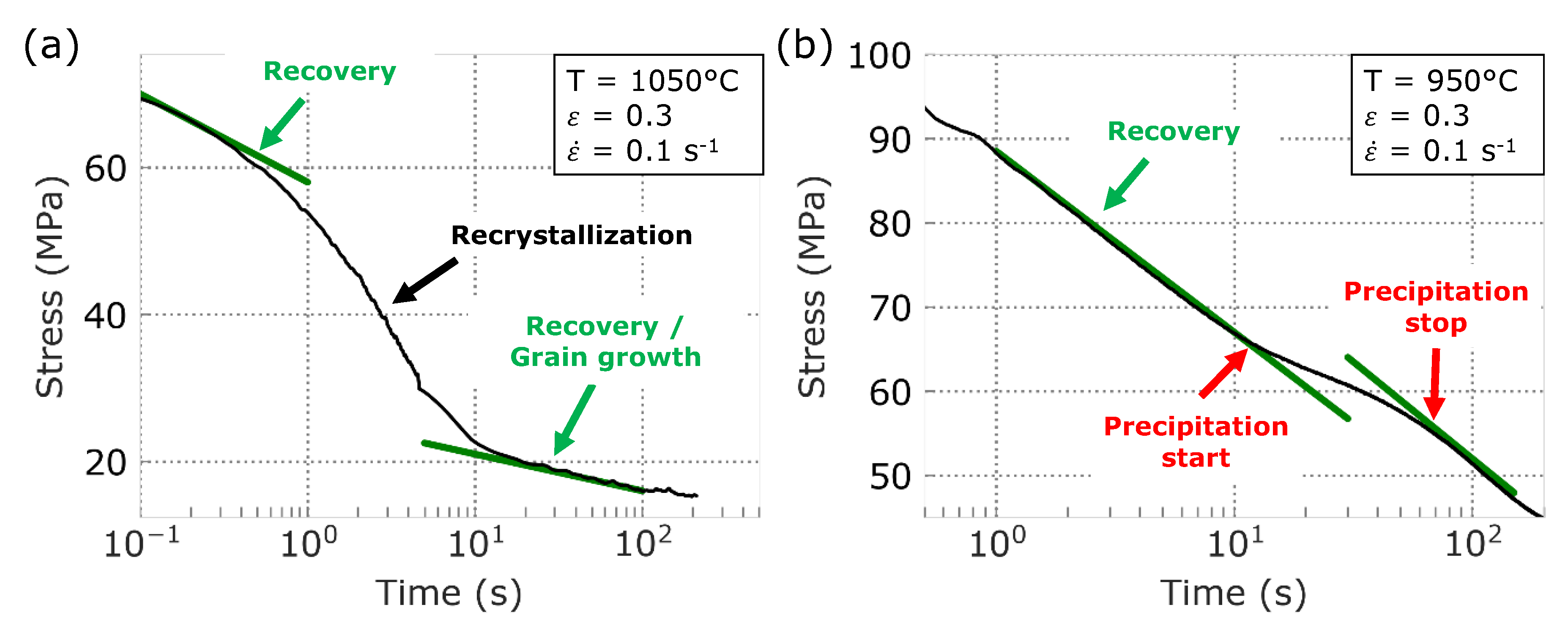
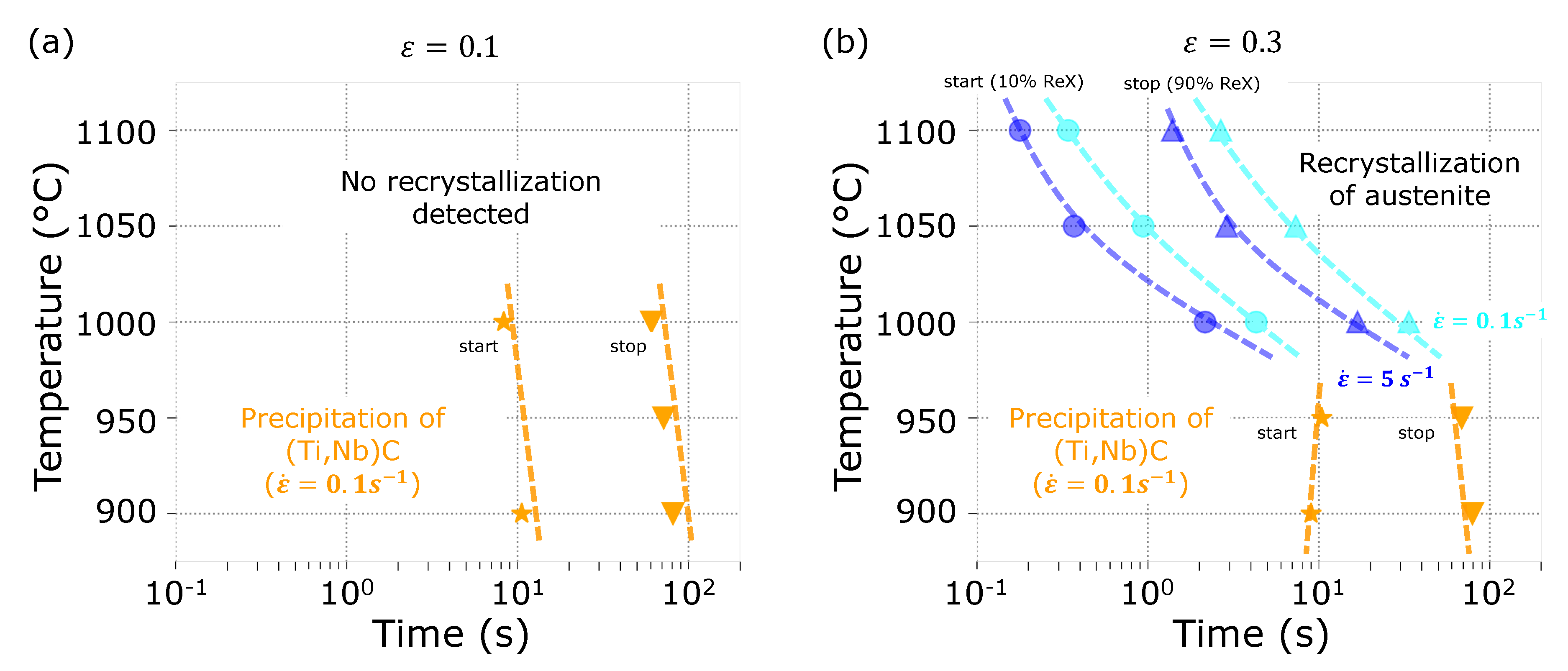
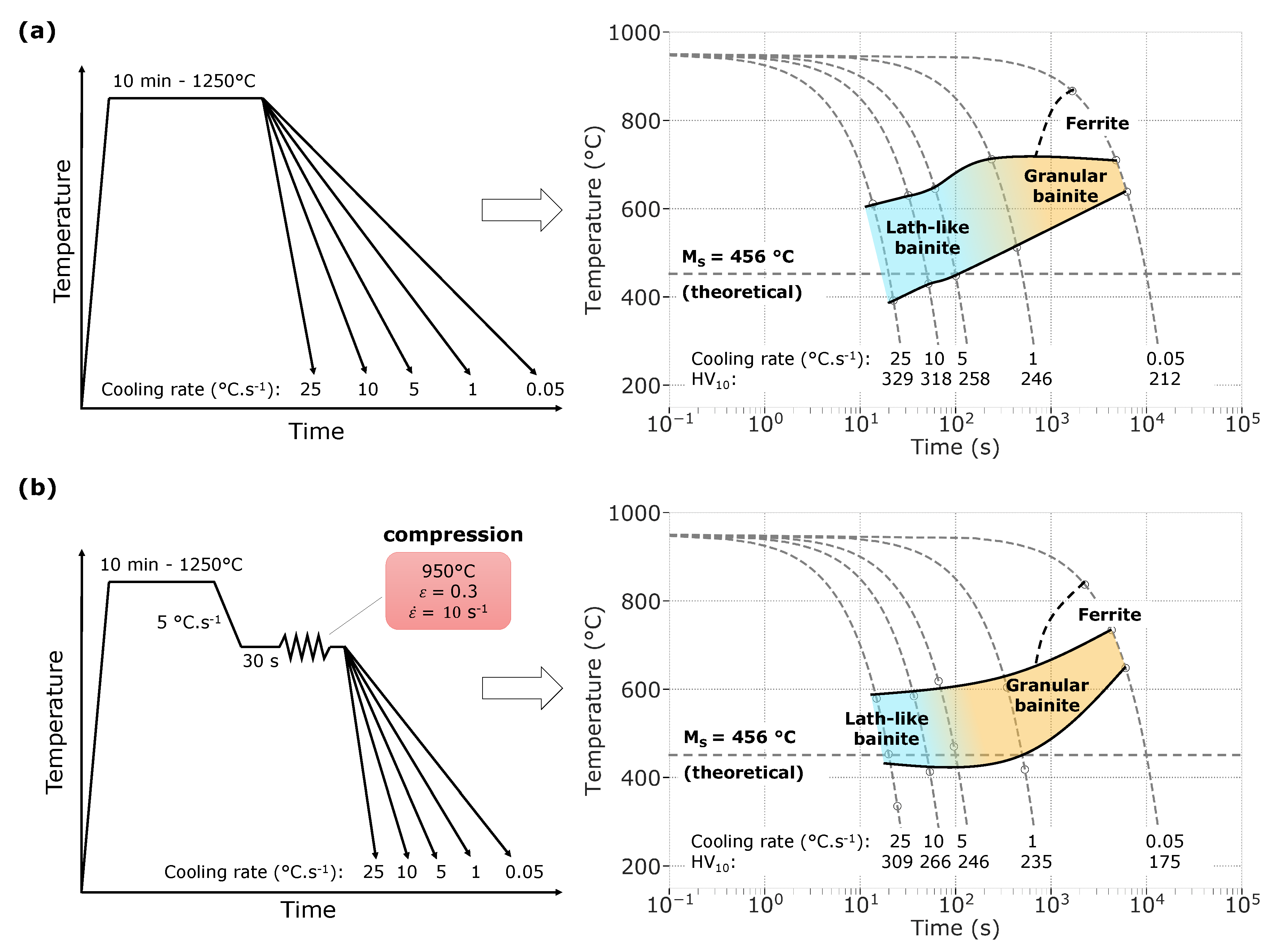

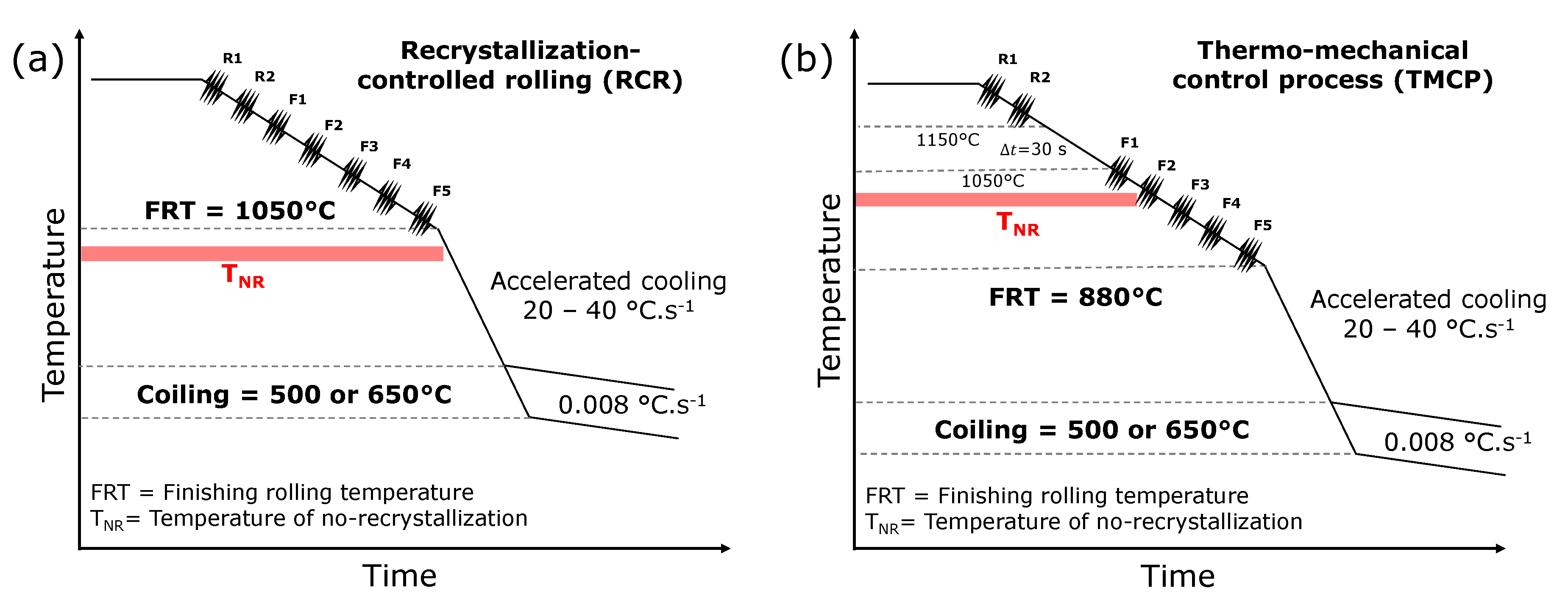

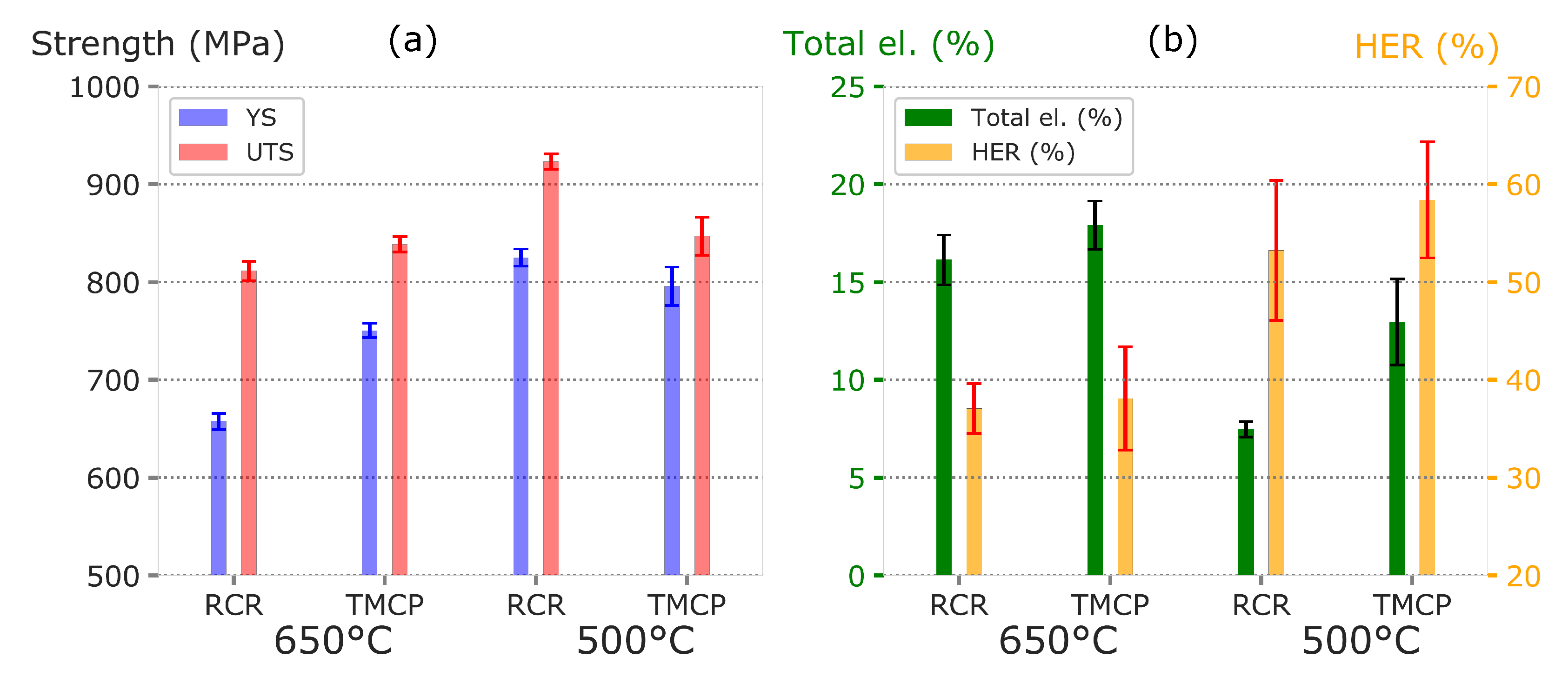
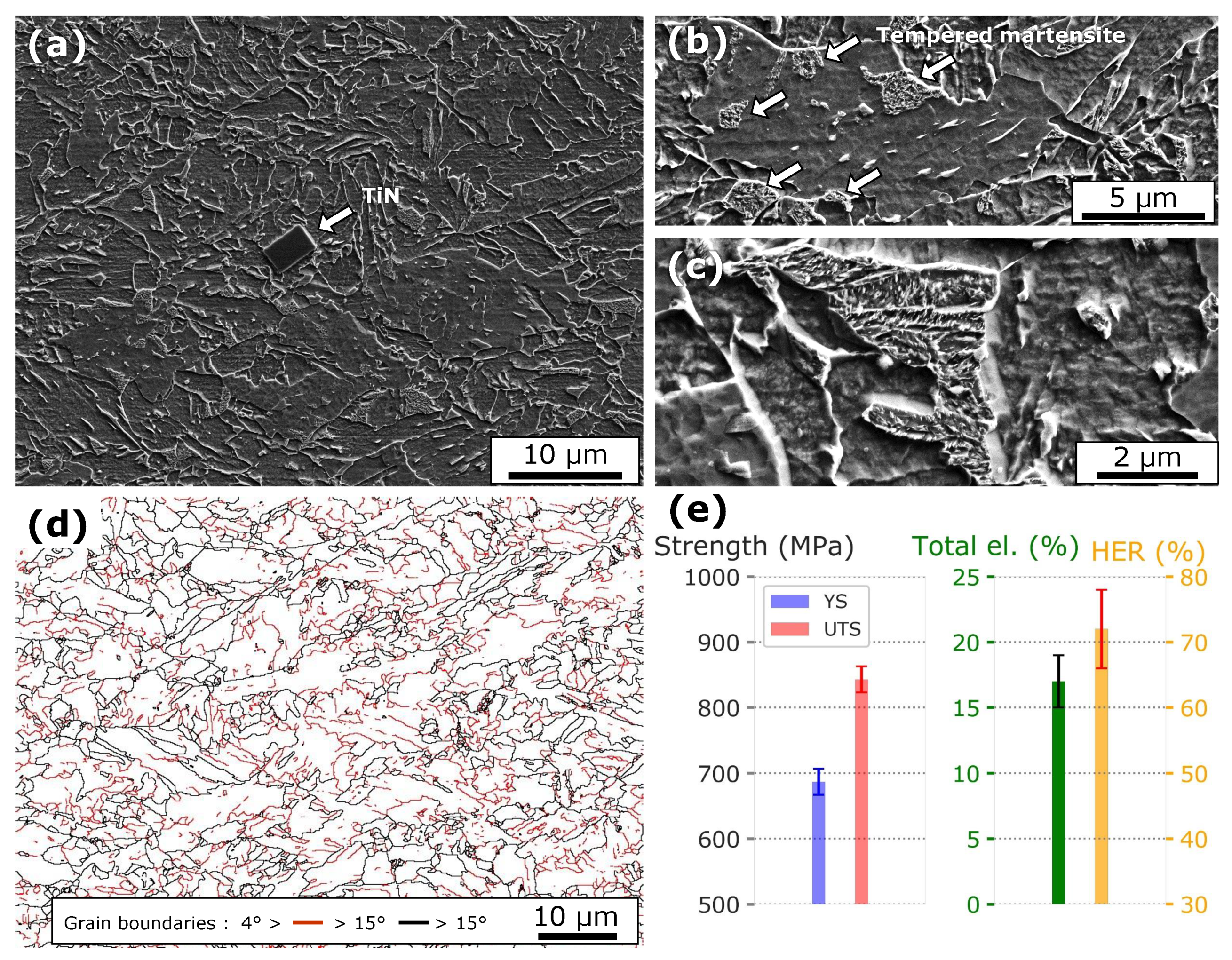
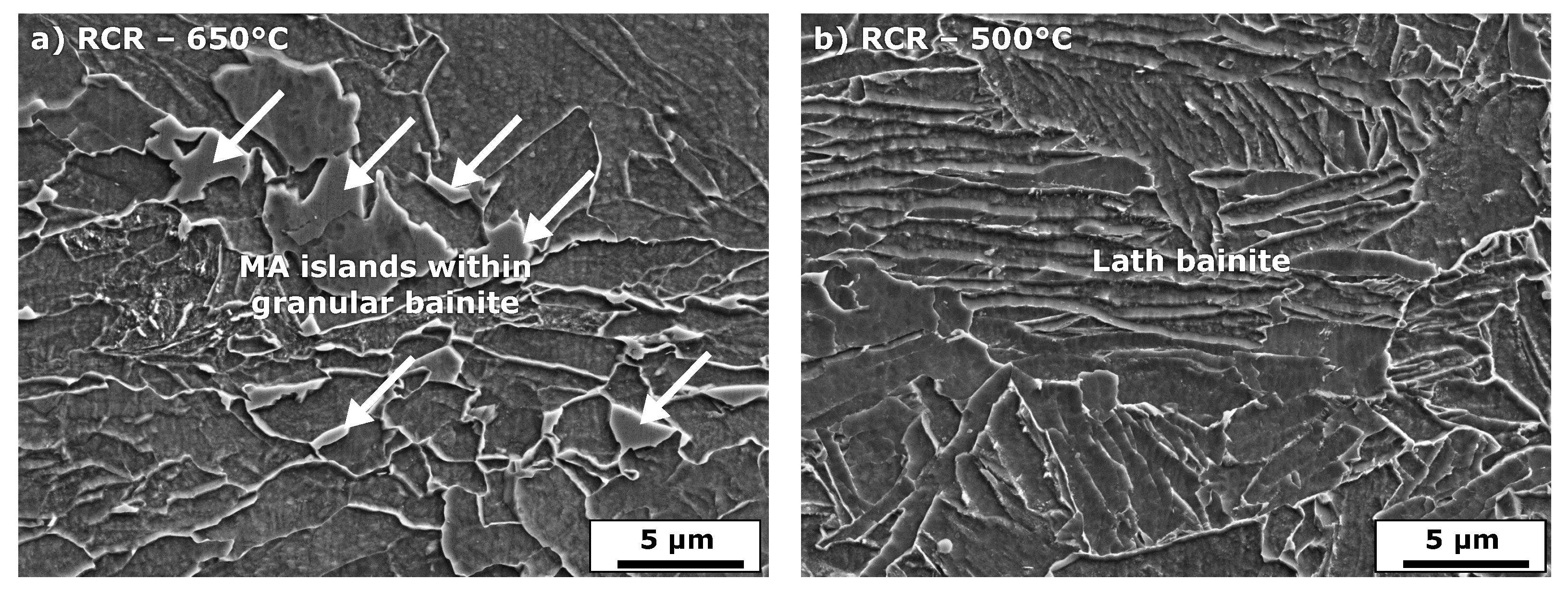
| Element (wt%) | C | Mn | Si | Ti | Nb | V | Mo | Al | Cr | N |
|---|---|---|---|---|---|---|---|---|---|---|
| Target | 0.06 | 1.9 | 0.5 | 0.1 | 0.04 | 0 | 0.2 | 0.05 | 0 | 0.005 |
| Lab-scale | 0.062 | 1.91 | 0.50 | 0.085 | 0.039 | 0.002 | 0.212 | 0.065 | 0.013 | 0.006 |
| Pilot Plant trials | 0.062 | 1.90 | 0.50 | 0.097 | 0.041 | <0.001 | 0.208 | 0.053 | 0.093 | 0.0039 |
| Industrial slabs | 0.061 | 1.91 | 0.50 | 0.1 | 0.040 | 0.008 | 0.191 | 0.067 | 0.034 | 0.005 |
© 2020 by the authors. Licensee MDPI, Basel, Switzerland. This article is an open access article distributed under the terms and conditions of the Creative Commons Attribution (CC BY) license (http://creativecommons.org/licenses/by/4.0/).
Share and Cite
Graux, A.; Cazottes, S.; Castro, D.D.; San-Martín, D.; Capdevila, C.; Cabrera, J.M.; Molas, S.; Schreiber, S.; Mirković, D.; Danoix, F.; et al. Design and Development of Complex Phase Steels with Improved Combination of Strength and Stretch-Flangeability. Metals 2020, 10, 824. https://doi.org/10.3390/met10060824
Graux A, Cazottes S, Castro DD, San-Martín D, Capdevila C, Cabrera JM, Molas S, Schreiber S, Mirković D, Danoix F, et al. Design and Development of Complex Phase Steels with Improved Combination of Strength and Stretch-Flangeability. Metals. 2020; 10(6):824. https://doi.org/10.3390/met10060824
Chicago/Turabian StyleGraux, Alexis, Sophie Cazottes, David De Castro, David San-Martín, Carlos Capdevila, Jose Maria Cabrera, Sílvia Molas, Sebastian Schreiber, Djordje Mirković, Frédéric Danoix, and et al. 2020. "Design and Development of Complex Phase Steels with Improved Combination of Strength and Stretch-Flangeability" Metals 10, no. 6: 824. https://doi.org/10.3390/met10060824
APA StyleGraux, A., Cazottes, S., Castro, D. D., San-Martín, D., Capdevila, C., Cabrera, J. M., Molas, S., Schreiber, S., Mirković, D., Danoix, F., Fabrègue, D., & Perez, M. (2020). Design and Development of Complex Phase Steels with Improved Combination of Strength and Stretch-Flangeability. Metals, 10(6), 824. https://doi.org/10.3390/met10060824









